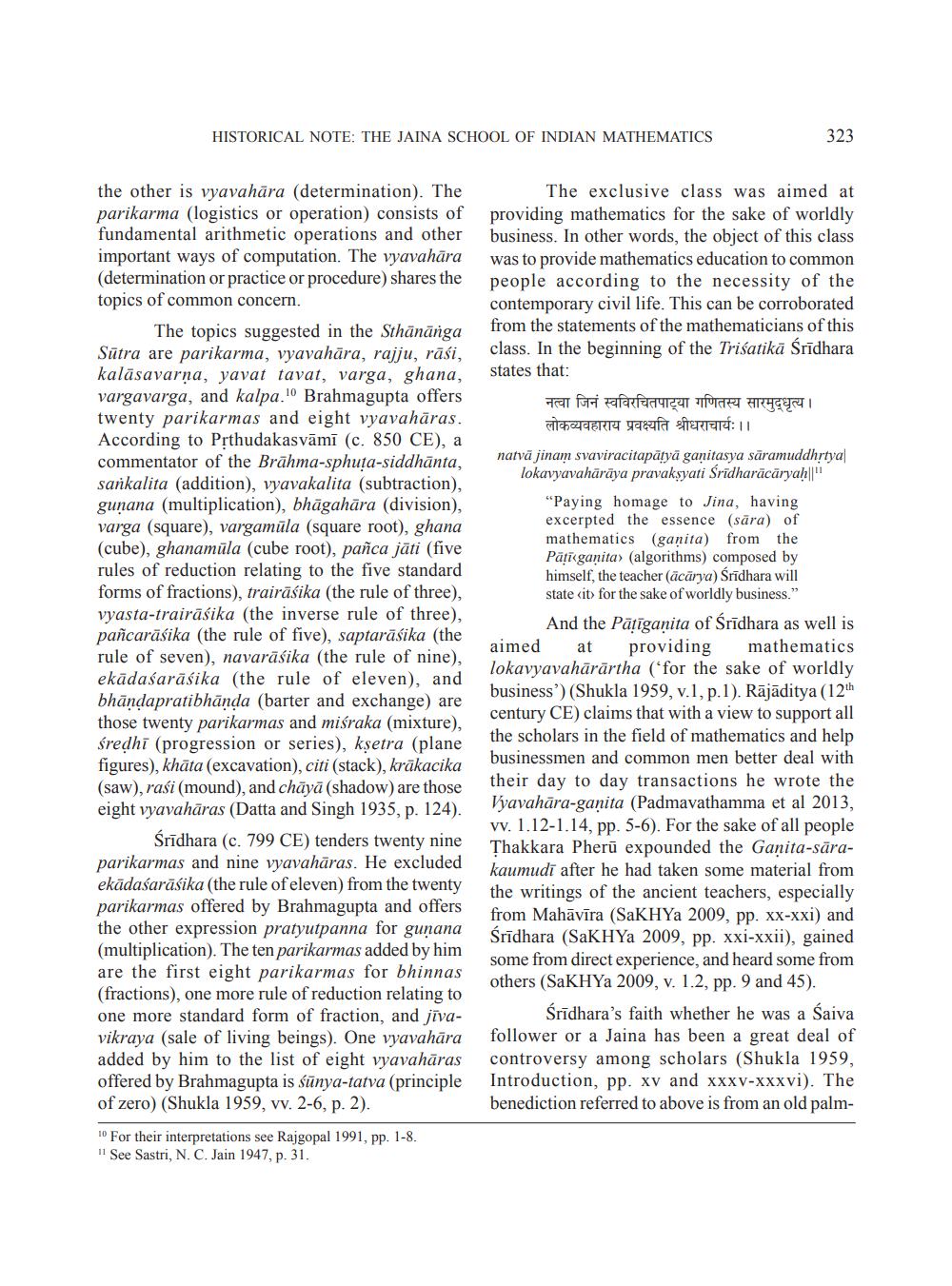Book Title: Jaina School Of Indian Mathematics Author(s): Dipak Jadhav Publisher: Indian Journal of History of Science View full book textPage 8
________________ HISTORICAL NOTE: THE JAINA SCHOOL OF INDIAN MATHEMATICS the other is vyavahära (determination). The parikarma (logistics or operation) consists of fundamental arithmetic operations and other important ways of computation. The vyavahara (determination or practice or procedure) shares the topics of common concern. The topics suggested in the Sthänänga Sätra are parikarma, vyavahära, rajju, rāši, kalāsavarna, yavat tavat, varga, ghana, vargavarga, and kalpa.10 Brahmagupta offers twenty parikarmas and eight vyavahāras. According to Pṛthudakasvāmī (c. 850 CE), a commentator of the Brahma-sphuta-siddhanta, sankalita (addition), vyavakalita (subtraction), gunana (multiplication), bhagahāra (division), varga (square), vargamala (square root), ghana (cube), ghanamila (cube root), pañca jāti (five rules of reduction relating to the five standard forms of fractions), trairāśika (the rule of three), vyasta-trairasika (the inverse rule of three). pañcarasika (the rule of five), saptarasika (the rule of seven), navarasika (the rule of nine), ekādasarasika (the rule of eleven), and bhandapratibhanda (barter and exchange) are those twenty parikarmas and miśraka (mixture). średhi (progression or series), kṣetra (plane figures), khāta (excavation), citi (stack), krakacika (saw), rasi (mound), and chaya (shadow) are those eight vyavahāras (Datta and Singh 1935, p. 124). Śrīdhara (c. 799 CE) tenders twenty nine parikarmas and nine vyavahāras. He excluded ekādasarāsika (the rule of eleven) from the twenty paríkarmas offered by Brahmagupta and offers the other expression pratyutpanna for gunana (multiplication). The ten parikarmas added by him are the first eight parikarmas for bhinnas (fractions), one more rule of reduction relating to one more standard form of fraction, and jīvavikraya (sale of living beings). One vyavahara added by him to the list of eight vyavahāras offered by Brahmagupta is sunya-tatva (principle of zero) (Shukla 1959, vv. 2-6, p. 2). 10 For their interpretations see Rajgopal 1991, pp. 1-8. 11 See Sastri, N. C. Jain 1947, p. 31. 323 The exclusive class was aimed at providing mathematics for the sake of worldly business. In other words, the object of this class was to provide mathematics education to common people according to the necessity of the contemporary civil life. This can be corroborated from the statements of the mathematicians of this class. In the beginning of the Trisatika Śrīdhara states that: नवाजिनं स्वविरचितपाट्या गणितस्य सारमुद्धृत्य । लोकव्यवहाराय प्रवक्ष्यति श्रीधराचार्यः ।। natvā jinam svaviracitapatyā ganitasya saramuddhṛtya lokavyavaharaya pravakya Sridharacāryaḥ "Paying homage to Jina, having excerpted the essence (sāra) of mathematics (ganita) from the Pati ganita (algorithms) composed by himself, the teacher (ācārya) Śrīdhara will state <it> for the sake of worldly business." And the Pariganita of Sridhara as well is aimed at providing mathematics lokavyavahārārtha ('for the sake of worldly business') (Shukla 1959, v.1, p.1). Rajaditya (12 century CE) claims that with a view to support all the scholars in the field of mathematics and help businessmen and common men better deal with their day to day transactions he wrote the Vyavahara-ganita (Padmavathamma et al 2013, vv. 1.12-1.14, pp. 5-6). For the sake of all people Thakkara Pheru expounded the Ganita-sarakaumudi after he had taken some material from the writings of the ancient teachers, especially from Mahāvīra (SaKHYa 2009, pp. xx-xxi) and Śrīdhara (SaKHYa 2009, pp. xxi-xxii), gained some from direct experience, and heard some from others (SaKHYA 2009, v. 1.2, pp. 9 and 45). Śrīdhara's faith whether he was a Śaiva follower or a Jaina has been a great deal of controversy among scholars (Shukla 1959, Introduction, pp. xv and xxxv-xxxvi). The benediction referred to above is from an old palmPage Navigation
1 ... 6 7 8 9 10 11 12 13 14 15 16 17 18 19
